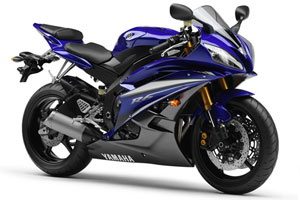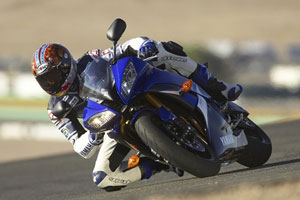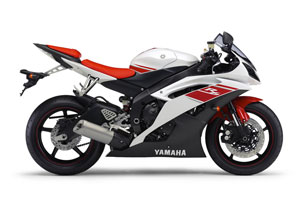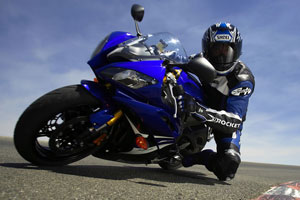A revised package for '08 looks to put Yamaha’s YZF-R6 another step ahead and begs you to open it right up.

TECHNICAL FEATURES:
Built to win
It’s no secret that almost every sportsbike on the road today is built with race track performance in mind, and the Yamaha YZF-R6 is one of the most successful Supersport racing motorcycles ever to hit the track.
Technology from the race track has been making its way to production bikes for a number of years now, although Yamaha pushes that fact with its YCC-T (Yamaha Chip Controlled Throttle) ride-by-wire system that was introduced on the R6 in 2006 — just like the MotoGP bikes.
Last year the R1 received a new piece of technology called the YCC-I (Yamaha Chip Controlled Intake) that uses the ECU to control variable-length intake trumpets in order to deliver optimal power dependant on RPM. This year the R6 receives the YCC-I and this system teams with the YCC-T for improved power delivery.
As stated in the main copy of this story, the compression ratio of the 599cc liquid-cooled DOHC inline four-cylinder engine is up from 12.8:1 to 13.1:1 (the highest of any Yamaha production bike) and this is mostly thanks to a newly designed piston with a slightly convex head shape and shallower valve recess.
While the compression is higher, the engine retains its 67 x 42.5mm bore and stroke and Yamaha claims that engineers made more than 50 friction-reducing refinements to the engine.
The engine also has a new crankshaft bearing that is wider and stronger, and the intake/exhaust valve springs uprated to an alloy of the highest possible stress tolerance and fatigue strength, to follow the cam profile more closely.
Its back torque-limiting slipper clutch design remains to significantly help backshifts on the unchanged six-speed gearbox.
Yamaha’s signature Deltabox aluminium frame is all new again for 2008, with thicker headpipe-headstock and swingarm pivot area walls. A frame cross-member has been removed to make the bike more flexible with a better balance, all set to improve the R6’s handling even further.
Although the frame is changed, the bike’s geometry stays the same, including the 24-degree rake, 3.8-inch trail and 54.3-inch wheelbase. The seat height also remains the same as ’07.
A magnesium subframe removes weight from the rear of the motorcycle for increased mass centralisation, and the swingarm has internal ribs added. The former extruded-aluminium section is now forged to work better with the new frame.
Revised outer fork tubes, a new lower triple clamp, and increased fork offset help improve front-end feedback over last year’s model, as does moving the seating position and ’bars forward and slightly lower (both by 5mm). This is also to help braking.
The front brake discs are now 310 x 5mm instead of 4.5mm for increased cooling over previous models.
One of the final changes of the new 2008 model YZF-R6 is the increased fork height adjustability and rear ride-height adjustment range, giving a greater adjustment window to suit a wider variety of riders.
SPECIFICATIONS
ENGINE
Engine type: Liquid-cooled, 4-stroke, DOHC, 4-valve, parallel four
Bore x stroke: 67 x 42.5mm
Displacement: 599cc
Compression ratio: 13.1:1
Transmission: Six speed
Power (claimed):135hp
Torque (claimed): 43ft-lbs
CHASSIS
Frame type: Dual beam aluminium
Front suspension: Fully adjustable 41mm USD fork
Rear suspension: Single mono-shock
Wheelbase: 1380mm
Wheels (front/rear): Not given
Tyres (front/rear): 120/70 ZR17MC (58W) / 180/55 ZR17M/C (73W)
Brakes (front/rear): Four Piston radially mounted twin 310mm discs / Single 220mm disc
DIMENSIONS
Weight (wet, claimed): 162kg
Seat height: 850mm
Fuel capacity: 17.3L
PURCHASE DETAILS
Price: TBA
Colour options: Team Yamaha Blue and White / Racing Red / Midnight Black
Test bike from: Yamaha Motor Australia (www.yamaha-motor.com.au)
It’s early and there are hardly any cars on the road to be seen. I’m heading down toward the south coast of New South Wales and can’t wait to arrive to sample some tight and twisty bends.
The long roads to get down to my destination seem to take forever but the ride is well worth it once arrived. The only problem is that it’s beginning to sprinkle.
Specks of water are beginning to splash over the windshield of the brand new 2008 model Yamaha YZF-R6 that I’m riding and I just hope this doesn’t turn into a complete downfall of rain.
As I ride further the clouds begin to disappear and the sun shines through. Thank gosh for that, because I wasn’t exactly looking forward to riding home on a long straight road getting soaked.
Soon enough I’m down near where I wanted to be and it’s easy to see because gone are the long stretches of never ending asphalt and now I have some fun little sweepers to contend with as I flow from one corner to another.
My boredom flies out the window as soon as I begin to find some turns to play on and the R6’s balance, feel and grip allow me to enjoy each section of the road as I relax and have complete trust in the chassis.
Leading the updates on the new bike is an all new cast aluminium frame which features thicker headpipe-headstock and swingarm pivot area walls, while a frame cross-member has been removed to make the bike more flexible with better balance.
A magnesium subframe removes weight from the rear of the motorcycle for increased mass centralisation, and the swingarm has internal ribs added. The former extruded-aluminium section is now forged to work better with the new frame.
What all this means on the road is that the well handling, race-winning, supersport bike will now be even more responsive for the rider and it shows when out on the road. It slices through turns like a hot knife through butter and the claim of better balance proves to be true.
Former R6’s have always handled magnificently and have been one of the quickest steering production motorcycles available, but the 2008 model improves that even further as its lightweight feel and agile character makes it almost effortless to steer at high or low speed.
That quick steering trait has been helped out this year with the more balanced frame, and Yamaha has placed more weight on the front wheel to help give that extra bit of confidence while in the saddle and pushing through the tighter stuff.
To do this, Yamaha has moved the seat position forward and has also moved the handlebars forward five millimetres. The ’bars are also five millimetres lower than in previous years, making the bike even sportier than before.
Those changes don’t really generate an entirely different seating position, but they do make the bike handle slightly different as the different position of body weight comes into play.
Also coming into play in the front-end handling department are revised outer fork tubes, a new lower triple clamp, and an increased fork offset to provide maximum feedback from the front of the bike.
I have to be honest and say any of the modern supersport bikes handle exceptionally well through smooth, tight and twisty roads, and it is hard to truly feel a major difference in the R6’s changes when riding sensibly on the road. Minor changes can be felt though.
The race track could prove to be a different story, where these chassis changes may just be enough for Aussie Broc Parkes and his Yamaha World SSP Racing Team to knock Ten Kate Honda off of the World Supersport Championship mantle, although out here on the open roads they don’t change a whole lot.
What does remain on the R6 is its fantastic ability to manoeuvre around any obstacle and the suspension rides over the bumps in a firm, but smooth, manner that is quit surprising for a sportsbike of this nature.
The 41mm upside-down fully adjustable forks work perfectly with the mono-shock bolted in the rear, providing a comforting ride that doesn’t send too many shocks through my back or wrists even on the bumpiest of surfaces.
One of the most exciting parts for me is a stretch of road that is surrounded by farms with plenty of hills and just the right amount of turns to have some fun on the bike. The asphalt is quality and the new Bridgestone BT-016 tyres have plenty of heat in them now that the sun is well and truly out to play.
This road is where I discover a whole new appreciation for the new Yami, enjoying each wheel turned and once again realising that these modern day street bikes perform better the harder they are ridden.
Shooting off through some tighter stuff covered by trees, I begin to ease up a bit as the tyres cool and the road slows. Instead of long and sweeping turns, I’m now dealing with tight switch backs as I climb a mountain.
The R6 continues to impress in these conditions and the slower speeds from heavy acceleration to harder braking allow me to get a feel for the brakes on the bike. Yamaha has opted for thicker front brakes discs for this year at 310 x 5mm (instead of 4.5mm last year) for better cooling.
Consistency is the key on hot summer days and the R6 brakes don’t fade one bit, with a solid feel allowing me to grab them in a hurry or just gently touching them, with both methods proving to work well.
Braking has never really been an issue on the R6 though, as its light weight of just 162 kilograms (claimed), combined with its slipper clutch, allows the anchors to pull the bike up without a slip up at any moment.
Accelerating out of those tight corners is where a major improvement lies over the previous incarnations of the middleweight screamer, with a revised 599cc engine having a little more steam in the mid-range to get it off the turns better.
A higher compression ratio bumps it from 12.8:1 up to 13.1:1 (the highest of any Yamaha production bike) and this is contributed by a newly designed piston with a slightly convex head shape and shallower valve recess.
Like the R1 from last year, the R6 now features the revolutionary YCC-I (Yamaha Chip Controlled Intake) that, based on rpm and the degree of throttle opening, instantly switches the air funnel length to improve cylinder filling and output.
As a high-rpm engine, the application of variable-length intakes has even more effect than it does on the R1, improving transitional power characteristics and power feel from mid-range through to 14,500rpm.
Those changes in this year’s bike make all the difference when giving it a good old kick in the guts out of a tight corner or up a hill. The increase in the mid section of the powerband is noticeable and is just what the R6 needed.
It might not have the low- to mid-range punch of the Honda, but it begins to pull slowly at around 8000rpm and once it hits around 10,500rpm it screams off and the rest is history. The R6 has one of the most aggressive powerbands of any of the 600s, making it quite a bit of work to get right in some areas.
But that lack of a real hit on the bottom-end also means it feels extremely smooth in low revs, with a great throttle response and no such jerk or anything at low rpm. Also like the R1, I can’t feel the YCC-I working when riding, but the R6 does have a nice variety of power throughout the range.
An impressive part of the liquid-cooled, four-stroke, DOHC, parallel four-cylinder engine is the improved throttle response over last year’s bike. A revised fuel injection mapping for the YCC-T (Yamaha Chip Controlled Throttle) dual-injector system complements the higher compression ratio and gives it that extra bit of smoothness when coming from zero throttle.
Even though the bulk of the R6’s power is up in the high part of the rev range, its fuel economy is still quite competitive at around six litres/100km, although my riding style tends not to rev the bike too high on most occasions.
Shifting gears is a cinch with the R6, as was the old model, and whether you are shifting down or up, the gears will select perfectly almost every time. Sometimes it is a little notchy on up shifts if I don’t quite match the revs correctly, but apart from that it is all good.
The only real trouble I did have during my time with the R6 was on the way back to Yamaha when the sump plug worked its way loose somehow and dropped the oil all over the asphalt and rear tyre in the process. We’re not sure what the cause was at this stage, but it was a lucky save on my part.
The MotoGP-inspired stumpy exhaust remains again and sounds superb, especially at high revs, although when rolling along a freeway or similar at low revs, the air induction noise is somewhat annoying as it howls and shrieks more than older versions.
It is only at a certain speed where it really begins to become a nuisance, but every time it does begin to make the noise I either click it back a gear or accelerate harder to try to get rid of it.
The shape of the intake mouth of the air cleaner box has been redesigned to reduce airflow resistance and improve intake efficiency, although I’m not sure if this is where the noise comes from exactly.
Speaking of the exterior of the bike, Yamaha has kept a similar look to last year’s model, with sharp, sleek and minimal lines making up the bodywork of the R6 and helping it look as racy as ever.
The major change in looks is at the front-end of the bike where the air induction is a different shape and stands out a little more, although I believe change is good for each year a bike is released.
At the tail of the bike it is a little bit thinner too, and it still has the number plate holder that can be removed without too much hassle at all.
Moto Online’s test bike is Team Yamaha Blue and White and is my favourite looking colour of the new models, although the Racing Red and Midnight Black both look pretty cool too.
As I said earlier, the seating position doesn’t really feel a lot different once riding the R6, yet when at a standstill it is a little more obvious that the seating has been moved forward and the ’bars have been lowered.
The entire cockpit on the R6 is exceptionally roomy for a short guy like me, and the entire setup is clean as per usual with all Yamahas. It just feels ‘finished’.
Everything from the looks and feel of the R6 scream ‘race bike’ as soon as you lay eyes on it and the styling attracts a hell of a lot of attention whether you’re out on the open roads or cruising around town.
Its willingness to ride hard through any given corner in the country is either a blessing or a cruel temptation, although I guarantee as soon as you get out of the twisty stuff on the R6 you will be wishing you could turn around for more.
The rain held off and I got plenty of kays under my belt in the saddle of Yamaha’s latest middleweight weapon, and to be honest, all I want to do now is take it to the race track. Its key features cry out for corners, wish to be opened right up, and love to be ridden hard.
But for now, I like my road licence in my wallet so I will have to continue my journey and soak in the improvements that Yamaha has provided at a nice leisurely pace. Can’t wait to catch up with my new friend at Eastern Creek.










Newsletter